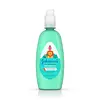What's inside
What's inside
 Key Ingredients
Key Ingredients

No key ingredients
 Benefits
Benefits

 Concerns
Concerns

 Ingredients Side-by-side
Ingredients Side-by-side

Water
Skin ConditioningAlcohol
AntimicrobialAmodimethicone
Glycerin
HumectantPhenoxyethanol
PreservativeCetrimonium Chloride
AntimicrobialDimethicone
EmollientSodium Citrate
BufferingDicocodimonium Chloride
EmulsifyingCitric Acid
BufferingSteartrimonium Chloride
PreservativePEG-200 Hydrogenated Castor Oil
EmulsifyingHydrolyzed Hyaluronic Acid
HumectantCreatine
Skin ConditioningCetearamidoethyl Diethonium Hydrolyzed Rice Protein
Sodium Dilauramidoglutamide Lysine
HumectantPropanediol
SolventDistearyldimonium Chloride
Behentrimonium Chloride
PreservativeGamma-Docosalactone
Skin ConditioningPhytosterols
Skin ConditioningCeteth-20
CleansingIsopropyl Alcohol
SolventWater, Alcohol, Amodimethicone, Glycerin, Phenoxyethanol, Cetrimonium Chloride, Dimethicone, Sodium Citrate, Dicocodimonium Chloride, Citric Acid, Steartrimonium Chloride, PEG-200 Hydrogenated Castor Oil, Hydrolyzed Hyaluronic Acid, Creatine, Cetearamidoethyl Diethonium Hydrolyzed Rice Protein, Sodium Dilauramidoglutamide Lysine, Propanediol, Distearyldimonium Chloride, Behentrimonium Chloride, Gamma-Docosalactone, Phytosterols, Ceteth-20, Isopropyl Alcohol
Ingredients Explained
These ingredients are found in both products.
Ingredients higher up in an ingredient list are typically present in a larger amount.
This water-soluble silicone is used for its hydrating and softening properties. It is used to add a silky feel to skincare products and has great benefits for haircare.
In haircare, this ingredient:
- Adds shine
- Protects color
- Offers thermal protection
- Boosts hair strength
- Does not build up as easily
This ingredient is a preservative and often used for it's anti-static properties. You'll most likely see this ingredient in hair conditioners.
It does not cause irritation or sensitization in leave-on products at 1-5%.
This ingredient is a preservative, antimicrobial, and emulsifier. It is often used in cosmetics for its ability to cleanse, condition, and reduce static.
Cetrimonium chloride is a quaternary ammonium salt, meaning it has a water-soluble structure.
Citric Acid is an alpha hydroxy acid (AHA) naturally found in citrus fruits like oranges, lemons, and limes.
Like other AHAs, citric acid can exfoliate skin by breaking down the bonds that hold dead skin cells together. This helps reveal smoother and brighter skin underneath.
However, this exfoliating effect only happens at high concentrations (20%) which can be hard to find in cosmetic products.
Due to this, citric acid is usually included in small amounts as a pH adjuster. This helps keep products slightly more acidic and compatible with skin's natural pH.
In skincare formulas, citric acid can:
While it can provide some skin benefits, research shows lactic acid and glycolic acid are generally more effective and less irritating exfoliants.
Most citric acid used in skincare today is made by fermenting sugars (usually from molasses). This synthetic version is identical to the natural citrus form but easier to stabilize and use in formulations.
Read more about some other popular AHA's here:
Learn more about Citric AcidDistearyldimonium Chloride is an antistatic agent and a surfactant.
Glycerin is already naturally found in your skin. It helps moisturize and protect your skin.
A study from 2016 found glycerin to be more effective as a humectant than AHAs and hyaluronic acid.
As a humectant, it helps the skin stay hydrated by pulling moisture to your skin. The low molecular weight of glycerin allows it to pull moisture into the deeper layers of your skin.
Hydrated skin improves your skin barrier; Your skin barrier helps protect against irritants and bacteria.
Glycerin has also been found to have antimicrobial and antiviral properties. Due to these properties, glycerin is often used in wound and burn treatments.
In cosmetics, glycerin is usually derived from plants such as soybean or palm. However, it can also be sourced from animals, such as tallow or animal fat.
This ingredient is organic, colorless, odorless, and non-toxic.
Glycerin is the name for this ingredient in American English. British English uses Glycerol/Glycerine.
Learn more about GlycerinWater. It's the most common cosmetic ingredient of all. You'll usually see it at the top of ingredient lists, meaning that it makes up the largest part of the product.
So why is it so popular? Water most often acts as a solvent - this means that it helps dissolve other ingredients into the formulation.
You'll also recognize water as that liquid we all need to stay alive. If you see this, drink a glass of water. Stay hydrated!
Learn more about Water